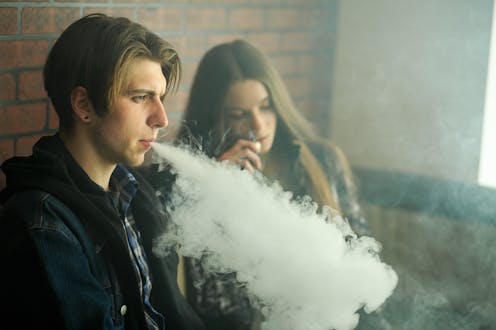Passive vaping – time we see it like secondhand smoke and stand up for the right to clean air
- Written by Renee Bittoun, Conjoint Professor of Nicotine Addiction, Avondale University and, University of Notre Dame Australia

A medical student of mine recently said he loved the smell of vanilla in the house he shared with friends who vaped. “That’s OK, right?” he asked. “Well no,” I said, “If you can smell the vanilla you are probably getting nicotine as well.”
Nicotine[1] is colourless and odourless, and is extremely well absorbed through your respiratory tract, including your nose, mouth, airways and even your ears[2].
Vapers exhale[3] nicotine and chemicals, including the sweet-smelling flavourings. Bystanders[4] can then breathe them in. The lung defences of smokers, vapers and bystanders are overwhelmed[5] by repeated exposure.
There is a lot of vaping going on[6] in young people aged between 18 and 24. Despite a good amount of debate about the health effects of vaping, there is scant discussion[7] around the risk of passive vaping and the consequences for the health and wellbeing of non-vapers and their right to inhale clean air.
Read more: Marketers are targeting teens with cheap and addictive vapes: 9 ways to stem rising rates of youth vaping[8]
Breathing out, breathing in
Researchers have examined the content of exhaled vapour from users in confined spaces, like cars[9], and larger venues. Although levels were lower than for tobacco cigarettes, they described[10] levels of the exhaled toxic substances as “ambient air pollution” that should be avoided to protect the health of non-smokers and non-vapers.
The evidence for the effects of passive vaping on the heart[11] is emerging but researchers have compared it to passive smoking, which can clog arteries and cause clotting problems. Publications that demonstrate the harmful respiratory effects[12] of passive vaping are growing[13].
Read more: Vaping-related lung disease now has a name – and a likely cause. 5 things you need to know about EVALI[15]
Lessons from passive smoking
In the late 1980s, passive smoking became the impetus to change legislation around tobacco use.
Health professionals had learnt decades earlier from a study of British doctors who smoked that tobacco smoking caused immense harm and early death in smokers[16]. But later they began to understand that living with a smoker, working with smokers or having close repeated exposure to someone else’s smoke could cause lung cancer, chronic bronchitis, worsen asthma and heart diseases in a non-smoker[17]. The effects of passive smoking on children too were very concerning[18].
Advocacy groups began defacing or “refacing” billboard tobacco advertising and ridiculing their advertising. In 1982, I wrote a paper published in the Medical Journal of Australia called A Tracheostomy for the Marlboro Man[19] about these efforts, the legal repercussions and the challenges from the tobacco industry.
By the 1990s, people had started suing[20] hospitality venues and workplaces for putting them in harms’ way by exposing them to “secondhand smoke”. Successes led to changes in legislation[21].
Attitudes[22] changed and non-smokers’ rights came to the fore. We were all able to live in a smoke-free environment in Australia for decades.
What does the law say about secondhand vapour?
In Australia, vaping restrictions are in line with laws around smoke-free areas[23] and World Health Organization[24] recommendations.
For example, New South Wales legislation says[25] people cannot use e-cigarettes in smoke-free areas under the Smoke-free Environment Act 2000. These include:
- all enclosed public places
- within ten metres of children’s play equipment
- public swimming pools
- spectator areas at sports grounds or other recreational areas used for organised sporting events
- public transport stops and platforms, including ferry wharves and taxi ranks
- within four metres of a pedestrian access point to a public building
- commercial outdoor dining areas
- in a car with a child under 16.
Vaping on public transport vehicles such as trains, buses, light rail, ferries is also banned[26].
But people are still vaping[27] in their homes and other places where it’s permitted. The attitudinal change[28] that made tobacco smoking around others socially unacceptable[29] is yet to develop.
Read more: My teen's vaping. What should I say? 3 expert tips on how to approach 'the talk'[31]
Are smoke-free areas enough?
Though debate continues about vaping, its safety and efficacy as a quitting aid, we cannot wait for years, to see the full effects of passive vaping.
Based on the public health precautionary principle[32], today’s challenge is to engage and inform non-vapers, particularly young non-vapers, about their rights to be “vape free”, breathe in clean air and take a stand.
Read more: Passive vaping: an impending threat to bystanders[33]
References
- ^ Nicotine (pubchem.ncbi.nlm.nih.gov)
- ^ your ears (research.avondale.edu.au)
- ^ exhale (www.cdc.gov)
- ^ Bystanders (theconversation.com)
- ^ overwhelmed (www.cdc.gov)
- ^ vaping going on (nceph.anu.edu.au)
- ^ scant discussion (doi.org)
- ^ Marketers are targeting teens with cheap and addictive vapes: 9 ways to stem rising rates of youth vaping (theconversation.com)
- ^ like cars (pubmed.ncbi.nlm.nih.gov)
- ^ described (pubmed.ncbi.nlm.nih.gov)
- ^ effects of passive vaping on the heart (openaccesspub.org)
- ^ harmful respiratory effects (www.mdpi.com)
- ^ are growing (www.nature.com)
- ^ Richard Mundl (CTK via AP Images) (photos-cdn.aap.com.au)
- ^ Vaping-related lung disease now has a name – and a likely cause. 5 things you need to know about EVALI (theconversation.com)
- ^ in smokers (www.ncbi.nlm.nih.gov)
- ^ non-smoker (ajph.aphapublications.org)
- ^ very concerning (doi.org)
- ^ A Tracheostomy for the Marlboro Man (www.bugaup.org)
- ^ suing (www.tobaccoinaustralia.org.au)
- ^ in legislation (doi.org)
- ^ Attitudes (www.tobaccoinaustralia.org.au)
- ^ smoke-free areas (www.tobaccoinaustralia.org.au)
- ^ World Health Organization (www.emro.who.int)
- ^ says (www.health.nsw.gov.au)
- ^ banned (www.health.nsw.gov.au)
- ^ still vaping (www.ncbi.nlm.nih.gov)
- ^ attitudinal change (www.tobaccoinduceddiseases.org)
- ^ socially unacceptable (www.ncbi.nlm.nih.gov)
- ^ Shutterstock (www.shutterstock.com)
- ^ My teen's vaping. What should I say? 3 expert tips on how to approach 'the talk' (theconversation.com)
- ^ precautionary principle (www.sciencedirect.com)
- ^ Passive vaping: an impending threat to bystanders (theconversation.com)

















